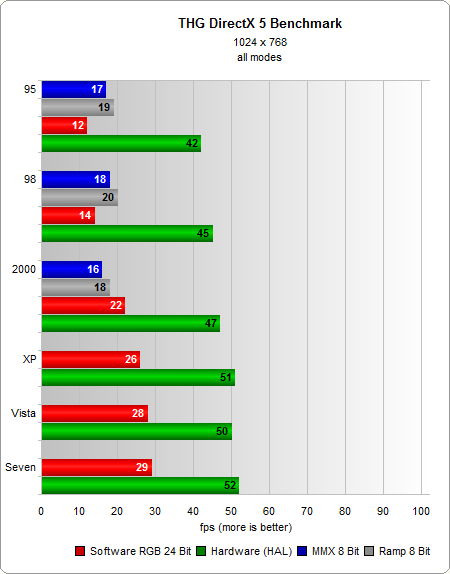Actually, we wanted to use the Microsoft flight simulator 95 / 98 as the DirextX5 test, which only ran until Windows 2000 without any errors. Two more games in the old Retained mode of DirectX 5/6 could be started by manual "reworking" of the Vista and Windows 7 installation routine, but a benchmark with Fraps was not technically possible.
To use DirectX5 requests under Vista, the following files had to be copied from an older DirectX distribution to the System32 directory:
- d3drm.dll
- d3drm.inf
- d3dim.dll
- d3dramp.dll
- d3dxof.dll
Nice side effect of repair: Older programs like Ulead Cool 3D also run on Vista and Windows 7. Ulead itself, on the other hand, still has no workaround. We have resorted to self-help due to all the incompatibilities and programmed a simple DirectX5 benchmark ourselves.
The test scenario consists of a simple world with walls, floors, ceilings, a panorama and two relatively high-resolution models. The entire project consists of almost 250,000 polygons and a total of 43 textures (512 x 512 pixels, 24 bit color depth). The test program was programmed in Retained mode for simplicity and ran in window mode with normal priority. In addition to normal materials and textures, we also used texture transparency to create a higher load. In order to test the Z-Buffer, we finally created a script that executes a 5-fold camera circulation. Until Windows XP, in addition to higher-quality software rendering and hardware-accelerated output, we also use MMX mode and 256-color RAMP mode, which was relatively common in 1995 when the CPU could not use MMX commands and did not use a 3D accelerator card for available.
The result is not surprising – all hardware-accelerated modes are much faster than software emulation. However, depending on the selected camera setting and image depth, the output is not completely error-free in contrast to software emulation. This ranges from clipping errors to problems in the z-buffer and erroneous texture representations (clearly visible in the image above).
- 1 - Evolution in kleinen Dosen – von Windows 95 bis Windows 7
- 2 - Schneller Fensterputzer – der Retro-Windows-PC entsteht
- 3 - Zahltag mit SuperPi
- 4 - Schweißtreibende Synthetik – MetaBench
- 5 - DirectX 5 – Der THG Do-It-Yourself Benchmark
- 6 - DirectX 6 – Asphalt-Pixel mit Need for Speed High Stakes
- 7 - DirectX 7 – James Bond für Feministinnen - No One Lives Forever
- 8 - DirectX 8 – Mafia, der Klassiker für die ganze Famile
- 9 - DirectX 9 – Die Sims 2 und die Generationenfrage
- 10 - Gegentest – Zwei alte CPUs gegen einen aktuellen Dualcore
- 11 - Zusammenfassung und Fazit – Die Zeit ist abgelaufen



































Kommentieren